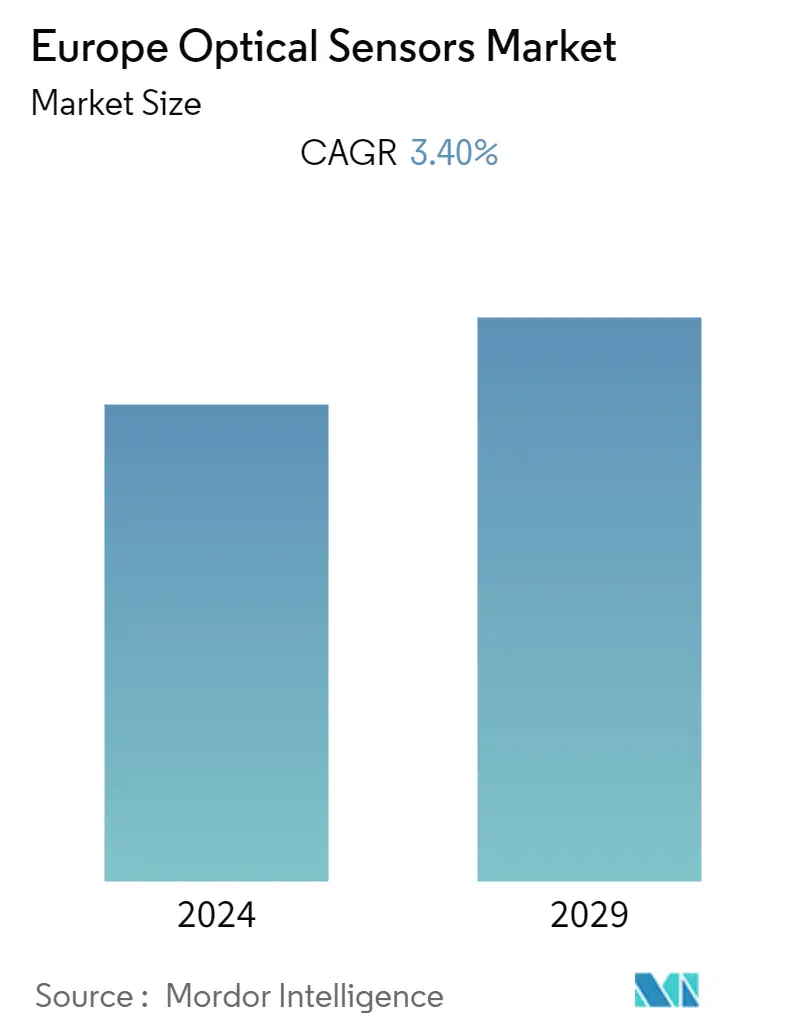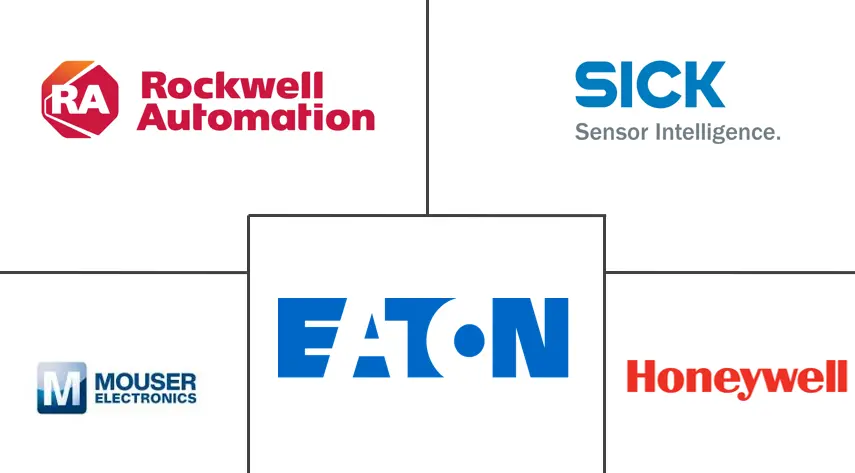Market Size of Europe Optical Sensors Industry

| Study Period | 2019 - 2029 |
| Base Year For Estimation | 2023 |
| Forecast Data Period | 2024 - 2029 |
| Historical Data Period | 2019 - 2022 |
| CAGR | 3.40 % |
| Market Concentration | Medium |
Major Players
*Disclaimer: Major Players sorted in no particular order |
Europe Optical Sensors Market Analysis
The Europe optical sensors market is expected to grow at a CAGR of 3.4% over the forecast period (2021 - 2026). The adoption of smartphones is quickly outpacing home gadgets in several users.
- Also, the increasing demand for advanced security features in smartphones has led to features, such as on-screen fingerprint scan, an optical sensor that detects and verifies fingerprints, driving the fiber optic sensor market.
- Ambient sensors measure the light in the room and adjust the screen's brightness accordingly. Thus, the increasing demand for smartphones is expected to drive the demand for these sensors.
- Optical sensors are also becoming an indispensable tool for manufacturers to save power, time, and money, because of the rapid and precise measurements they provide. Moreover, as these sensors have applications in intelligent lighting, they help save power, as they do not rely on a manual on-off switch but turn on light according to the natural light in the premises.
- The imbalance between image quality and price has led to increased competition, particularly for the consumer electronics segment, which has some of the most established players facing peer pressure over optimal pricing. Several small players are also facing difficulty over product differentiation, which leads to a potential barrier for their entry into high-volume applications. In this case, successful product differentiation can move a product from pure pricing to non-pricing factors.
- Thus, companies are vying to overcome this challenge by focusing on advanced and efficient technologies that would help minimize sensors and superior performance. The increasing adoption of these sensors in non-traditional fields, such as automation (mobile robots), is expected to overcome this challenge.
- The COVID-19 pandemic has seriously impacted the semiconductor sector, curbing demand in the optical sensor industry. According to the Semiconductor Industry Association, semiconductor sales in the first quarter of 2020 fell 3.6% due to the severe disruption of international supply chain activities due to the COVID-19 pandemic. In addition, some major automotive and consumer electronics OEMs have shut down manufacturing operations due to various government blockade scenarios, resulting in lower sales of optical sensors.
Europe Optical Sensors Industry Segmentation
Optical sensors are used in various commercial and research applications, such as quality and process control, medico technologies, metrology, imaging, and remote sensing. R&D in the field is driven by the expectation that optical sensors will have significant advantages over the conventional sensor types in terms of their properties.
| By Type | |
| Extrinsic Optical Sensor | |
| Intrinsic Optical Sensor |
| By Sensor Type | |
| Fiber Optic Sensor | |
| Image Sensor | |
| Photoelectric Sensor | |
| Ambient Light and Proximity Sensor | |
| Other Sensor Types |
| By Application | |
| Industrial | |
| Medical | |
| Biometric | |
| Automotive | |
| Consumer Electronics | |
| Other Applications |
| By Country | |
| Germany | |
| United Kingdom | |
| France | |
| Rest of Europe |
Europe Optical Sensors Market Size Summary
The Europe optical sensors market is experiencing a steady growth trajectory, driven by the increasing integration of these sensors in various applications across consumer electronics, automotive, and industrial sectors. The rising demand for advanced security features in smartphones, such as on-screen fingerprint scanning, is a significant factor propelling the market. Optical sensors are also becoming essential in intelligent lighting systems, offering energy efficiency by adjusting brightness based on ambient light levels. However, the market faces challenges such as intense competition in the consumer electronics segment, where companies are striving for product differentiation to overcome pricing pressures. The adoption of optical sensors in non-traditional fields like automation and mobile robotics is expected to mitigate these challenges and expand market opportunities.
The automotive industry is a key contributor to the optical sensors market, with these sensors being integral to camera-enabled systems for autonomous driving, advanced safety, and in-vehicle infotainment. The development of Advanced Driver Assistance Systems (ADAS) and self-driving cars, particularly in Germany, is expected to boost market demand. Despite the setbacks caused by the COVID-19 pandemic, which disrupted supply chains and affected semiconductor sales, the market is poised for recovery as technology adoption increases. Strategic collaborations and acquisitions among major players, such as TE Connectivity's acquisition of First Sensor AG, are enhancing market capabilities and expanding product offerings. These developments underscore the competitive nature of the market, with companies focusing on innovative technologies to maintain and grow their market share.
Europe Optical Sensors Market Size - Table of Contents
-
1. MARKET DYNAMICS
-
1.1 Market Overview
-
1.2 Introduction to Market Drivers and Restraints
-
1.3 Market Drivers
-
1.3.1 Increasing Market Penetration of Smartphones
-
1.3.2 Increasing Demand for Power-saving Devices Across Industries
-
1.3.3 Increasing Market Penetration of Automation Techniques Across Various Industries
-
-
1.4 Market Restraints
-
1.4.1 Imbalance Between the Image Quality and Price
-
-
1.5 Value Chain / Supply Chain Analysis
-
1.6 Industry Attractiveness - Porter's Five Forces Analysis
-
1.6.1 Threat of New Entrants
-
1.6.2 Bargaining Power of Buyers
-
1.6.3 Bargaining Power of Suppliers
-
1.6.4 Threat of Substitute Products
-
1.6.5 Intensity of Competitive Rivalry
-
-
-
2. MARKET SEGMENTATION
-
2.1 By Type
-
2.1.1 Extrinsic Optical Sensor
-
2.1.2 Intrinsic Optical Sensor
-
-
2.2 By Sensor Type
-
2.2.1 Fiber Optic Sensor
-
2.2.2 Image Sensor
-
2.2.3 Photoelectric Sensor
-
2.2.4 Ambient Light and Proximity Sensor
-
2.2.5 Other Sensor Types
-
-
2.3 By Application
-
2.3.1 Industrial
-
2.3.2 Medical
-
2.3.3 Biometric
-
2.3.4 Automotive
-
2.3.5 Consumer Electronics
-
2.3.6 Other Applications
-
-
2.4 By Country
-
2.4.1 Germany
-
2.4.2 United Kingdom
-
2.4.3 France
-
2.4.4 Rest of Europe
-
-
Europe Optical Sensors Market Size FAQs
What is the current Europe Optical Sensors Market size?
The Europe Optical Sensors Market is projected to register a CAGR of 3.40% during the forecast period (2024-2029)
Who are the key players in Europe Optical Sensors Market?
Mouser Electronics, Sick AG, Rockwell Automation, Honeywell International Inc and Eaton Corporation PLC are the major companies operating in the Europe Optical Sensors Market.

